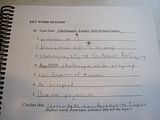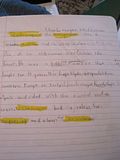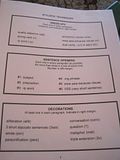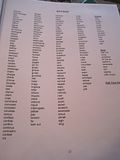Thanks for getting back to me and answering my questions, Stephanie!

My memory isn't always spot on these days, so I pulled out Wyatt's RTR work with Charlemagne for help.

skwmackey wrote:... We actually did the outline together this time since this was the first lesson he had to choose only certain sentences to use. I made the mistake of helping an little to much in telling him ways to abbreviate. Then, when it was time for the rough draft, he couldn't remember what the abbreviations stood for...
I did the same thing you did at first. I gave examples of drawing short pics to jog my memory, and my ds used them and then couldn't remember them. I learned the same thing you did - my pics aren't helpful for him because he forgets what they mean, but his are. So, I just jotted the words above the pictures for him for that one. Anyway, that was before Charlemagne though.

My ds didn't use many pictures first. He used words in short phrases. Key word outlines are to be kept short with about 3 words from each sentence on the lines of the blank outline. Words chosen should help students best remember the main ideas of the sentences. Abbreviations and symbols may be used, but not every student will use these as much as another may.

I think it is important to let students put their own mark on the key words outlines, as they will better remember them then. However, at first, they may need help picking out the important words from a sentence. Here are Wyatt's key word outlines for Charlemagne...


skwmackey wrote:...Anyway, the first challenge started when he had to only choose the parts that spoke of Charlemagne as a conqueror. I struggled to help him find the sentences that went with the topic unless I was looking at the answers. He got really confused when we started talking about topic sentences and the clincher idea. It didn't help that I didn't seem to know a good way to explain what a topic sentence is... I did not provide a sample paragraph with a clear topic sentence and clincher besides the one in the teacher's manual. Maybe I should find another one or two, so he can see more examples...
Going over a few examples of topic sentences was helpful to Wyatt.

This needn't be exhaustive, but rather just reading a paragraph and pointing out the first sentence (which 99% of the time is the topic sentence) and the last sentence (which is the clincher). You can use your R & S English book for this if you'd like, as all of their paragraphs have solid topic sentences and stress unity and order. Any of the lessons on "paragraphs" should work fairly well. As far as the Charlemagne lesson, it helped Wyatt for me to write the topic sentence and the clincher only on a markerboard, and then underline/box the repeating words to stress the big idea. We did this with the Charles Martel example. Then, for the outline of Charlemagne, I wrote "Charlemagne" and "conqueror" on the markerboard, and when choosing which sentences to keep and which to omit, he could refer to the markerboard to remind him of topic.

For now, I think I'd wrap up the lesson and help him quite quickly write a paragraph about Charlemagne, and then move on. Students will be using this skill each time they complete a writing lesson in "Medieval History-based..." so this isn't a one shot skill that must be mastered the first time it's introduced.

Here is a copy of Wyatt's final Charlemagne paragraph, just for another example of one...

Finally, as far as the dress-ups, I printed these and put them in plastic sleeves for Wyatt to refer to. He could use these pages while writing at any time. I also had him flip through his vocabulary cards and try to use those in his writing. This is not giving too much help, but rather training dc to use resources (similar to a thesaurus or dictionary) to help them add more unusual, vivid words to their writing...



Before he could hand in his writing to me, I'd ask him to check for each of the things noted in the Rough Draft boxed section of required elements. If he was still missing something, I'd flip open his red folder and have him use the appropriate list to fix it. For example, I might say, "You've used 2 banned words. See if you can find them in your writing." And I'd flip to the "banned words" section to help him. Then, after he'd found the banned words, I'd flip to the appropriate section in his folder to help him, and he could choose an appropriate word from that.

I hope this helps, but it will take awhile for each of these mini-lessons to sink in, and there will be ample practice throughout the year with each skill taught. I think I'd just give a few more examples of good topic sentences/clinchers, jot "Charlemagne" and "conqueror" on a markerboard, construct a paragraph from the key word outline already written, use your folder to help with any needed changes, and move on. It sounds like everything is moving along just fine, and with a little recap of the mini-lesson, you'll be good to go on the next one as it will review the concept again anyway. HTH!

In Christ,
Julie





